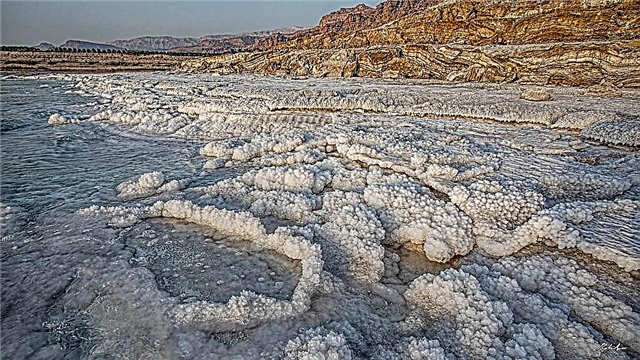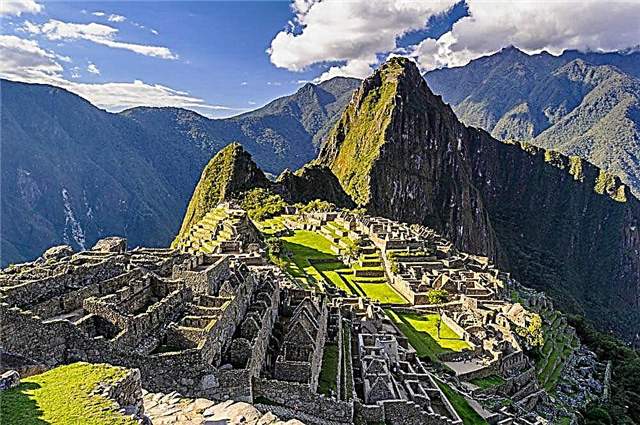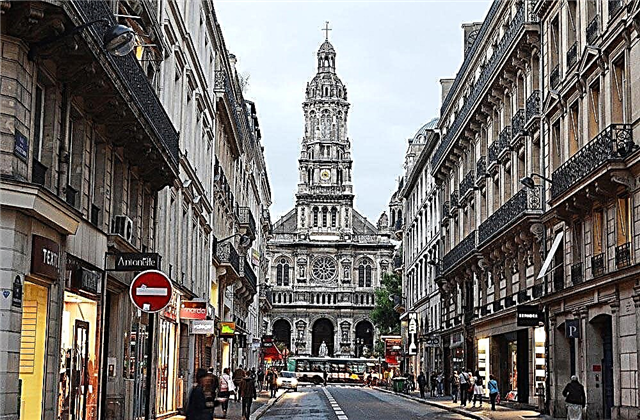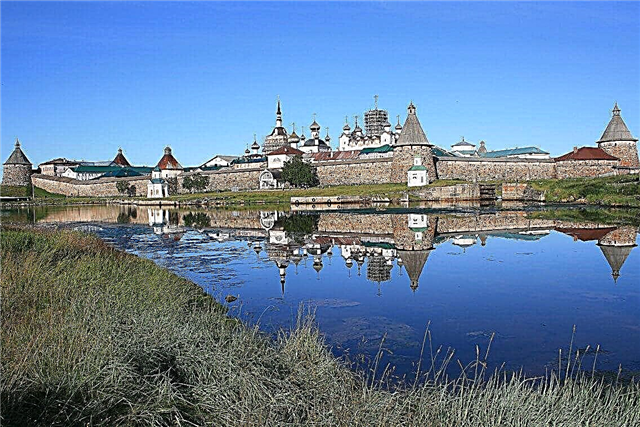The monasteries of the Arkhangelsk region have their own history, which differs from the monasteries of Russia. Many of them were founded by hermits who were able to gather spiritual people around them and create major centers of religious life. First monasteries, then deserts, then monasteries - this is the path that many monasteries have traveled. Despite the harsh nature of the North, the monks were able to equip real households within the walls of the monastery, build stone churches and temples.
But the remote location did not save the monasteries of the Arkhangelsk North from the anti-religious activities of the Soviet regime. About one and a half tons of silver, several kilograms of gold and almost 2000 precious stones were requisitioned from the Solovetsky Monastery alone. The revival of monastic life began only at the end of the 19th century. Most of the renovation is funded by donations from the parishioners.
The most famous monasteries in the region
Active male and female cloisters. Holy places, list, photos with names and descriptions!
Solovetsky monastery
Monastery for men. Construction began on the eponymous island in the White Sea in the 1420s. In Soviet times, the Solovetsky forced labor camp, one of the largest in the USSR, worked on its territory. It was only in 1990 that traditional religious life was resumed. The Solovetsky Museum-Reserve, which includes a complex of monuments, is not only protected by the state, but is also included in the UNESCO World Heritage Site.
Address: Solovetsky village
Site: solovki-monastyr.ru

Anthony-Siysk monastery
Founded in 1520. Its architectural ensemble is made up of the Sergievskaya Church, the Trinity Cathedral, and the Annunciation Church. 10 kilometers from the monastery there is the Holy Lake, according to legend, the water in it is curative. In 1730, Mikhail Lomonosov lived in a monastery on his way to Moscow. The monastery was closed during Soviet times, some of the buildings collapsed. The revival of the monastery took place in 1992. About 5 thousand pilgrims visit the monastery every year.
Address: the village of Anthony-Siysky monastery
Website: www.siyskiymonastyr.rf

Artemievo-Verkolsky Monastery
In 1635, a church was built in the name of the holy youth Artemy Verkolsky, with this the history of the monastery began. He survived several major fires, in which only four bells and the relics of St. Artemius survived. With the advent of Soviet power, that part of the brethren that did not have time to leave for other monasteries was shot. For 70 years, the monastery was plundered. Now on the territory of the monastery there are churches and temples rebuilt anew.
Address: Verkola village
Website: www.verkola.ru

Alexander Oshevensky monastery
This monastery was founded in the 1460s. In 1707, the Cathedral of the Assumption of the Blessed Virgin Mary was erected, which is considered the main temple of the monastery. At present, almost nothing remains of it, but the relics of the founder of the monastery, Alexander Oshevensky, are kept under the cover of this temple. Divine services are held in the Church of St. Nicholas the Wonderworker. The monastery is in need of restoration, but is not receiving the necessary funding.
Address: village Pogost
Website: oshevenskoe.ru

Epiphany Kozheozersky Monastery
One of the most inaccessible monasteries in Russia. From the city of Onega to the monastery 110 km. 80 of them need to be overcome by a timber truck, and then another 30 km on foot. Pilgrims go there for solitude, away from the civilized world. But the monastery gladly accepts the help of those who help in equipping believers in such a remote place in the northern forests. There is no mobile communication and no electricity on the territory of the monastery.
Address: Kozhposyolok
Website: kozhozero.ru/

Nikolo-Korelsky monastery
Date of foundation - the beginning of the 15th century. Closed by the Bolsheviks in the 1920s. Located on the territory of Sevmash in Severodvinsk. This plant specializes in the construction and repair of nuclear submarines. In some of the former churches, there are divisions of the enterprise. The enterprise is secure, therefore free passage to the territory is prohibited. Part of the wooden wall of the 17th century monastery is now located in Kolomenskoye.
Address: Severodvinsk, Arkhangelskoe highway, 38
Site: nikolo-korel29.ru

Sursky Ioannovsky monastery
Convent, founded in 1900 from the Sursk women's community. He was known for his charitable activities - the sisters helped the families of the dead soldiers, there were schools for children and adults. Both the monastery and schools were closed in the 1920s. After the reconstruction of the female community of the Sursky courtyard and the opening of the monastery in 2012, it is planned to revive the traditions of the monastery's charitable activities.
Address: s. Sura, st. I. Kronstadtsky, 4
Site: sura-monastery.ru

John the Theologian monastery
Founded after the sisters' attempts to return one of the buildings of the St. John the Theologian-Sursky convent of the Arkhangelsk courtyard. The monastery was moved to the village of Ershovka in 1996. New temple buildings were erected in the places where dozens of people were shot in the 30s of the XX century. And the official opening of the monastery took place only in 2012. There was a shelter for orphans and children from disadvantaged families at the monastery.
Address: d. Ershovka

Onega Cross Monastery
Monastery for men. Doesn't work now. Founded in 1656. Its buildings of the 17th-19th centuries are interesting for connoisseurs of Russian architecture. Of particular interest is the Cathedral of the Exaltation of the Cross, built in 1660. One of the weirdest wooden temples now houses a residential building. It is believed that this building was built during the reign of Patriarch Nikon. You can get to the monastery by sea from the city of Onega.
Address: Kiy Island

Koryazhemsky Nikolaevsky monastery
Founded in 1535. In the temple of Longin of Koryazhemsky there are shrines of the monastery - chains and hair shirt of its founder. Two iconostases of the temple were made by Anatoly Parferov, a woodcarving master. Divine services are held in the temple. Some of the old monastic documents were deposited in the Russian State Archive of Ancient Acts. A large-scale restoration of the Church of the Savior Not Made by Hands has been carried out.
Address: Koryazhma, st. Embankment them. N. Ostrovsky (st.Kedrova)

Sketes, deserts and courtyards of the Solovetsky Monastery
Ascension skete
It is located 11 km from the Solovetsky Monastery on one of the highest mountains of the archipelago - Sekirnaya. Built in the 19th century. A feature of the temple is the lighthouse under its dome. He points the way to the courts ever since. There was a punishment cell in the skete at the time of the ELEPHANT. In their memory, a chapel was founded in honor of the New Martyrs and Confessors of Russia.

Savvatievsky skete
One of the oldest sketes of the Solovetsky Monastery. At various times, it housed the corps of the Solovetsky camps and the school for the young men of the Northern Fleet. Attempts in the 80s of the XX century to equip recreation centers in the skete did not bring success. And since 1993, monastic life began again in Savvatyevo. Restoration work is underway. There are various people among the volunteers - both pilgrims and students of Moscow schools.

Calvary-Crucifixion Skete
The foundation of the skete is the beginning of the 18th century. The architecture of the skete is represented by the wooden church of the Resurrection of Christ in 1715 and the Church of the Crucifixion of Christ in 1827. In the department of the Solovetsky camp, women-criminals and priests were kept here. In 1994, at Mount Golgotha, a worship cross was erected in memory of the Orthodox clergy who were imprisoned. A visit to the skete is possible only with a monastery guide.

Holy Trinity Anzersky Skete
Founded at the beginning of the 17th century. Monks came here looking for a secluded life, because Anzer Island is the northernmost of the Solovetsky archipelago. This skete also did not escape the fate of becoming one of the branches of the Solovetsky camp. After the abolition of the camp, the skete fell into desolation, and monastic life in it resumed only in 2001.Only ruins remain of many of the skete's buildings, and a lot of restoration work is required.

Andreevskaya hermitage
Built in the 16th century on the Big Hare Island. In 1702, the skete was visited by Tsar Peter I. He ordered to establish a church on the island in honor of the patron saint of the Russian fleet, Andrew the Primordial. The wooden church was erected just two weeks after Peter I left the island. At different times, the construction of the skete was occupied by the customs of the archipelago and the department of the Solovetsky camp. The skete is active, the restoration of St. Andrew's Church is underway.












